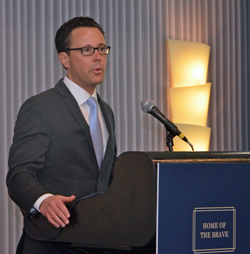The latest U.S. Solar Market Insight 2014 Year in Review has been released and solar had another banner year. Newly installed solar photovoltaic (PV) capacity for the year reached a record 6,201 megawatts, more than 30 percent higher than in 2013. An additional 767 MW of concentrating solar power (CSP) also came online during 2014. Solar accounted for 32 percent of the nation’s new generating capacity in 2014, beating out both wind energy and coal for the second year in a row. Only natural gas constituted a greater share of new generating capacity. The report was released by GTM Research and the Solar Energy Industries Association (SEIA).
The solar industry broke the gigawatt (GW) level in 2011 and in 2014, 3.9 GW of utility-scale sized solar power projects came online with an additional 14 GW under contract. The commercial segment in the U.S. also first installed more than 1 GW  in 2011 but has not shared the same success as the utility-scale segment. In 2014, the commercial segment installed just over 1 GW, down 6 percent from 2013. The report notes, “Many factors have contributed to this trend, ranging from tight economics to difficulty financing small commercial installations.” But GTM Research expects 2015 to be a bounce-back year for the commercial segment, highlighted by a resurgence in California.
in 2011 but has not shared the same success as the utility-scale segment. In 2014, the commercial segment installed just over 1 GW, down 6 percent from 2013. The report notes, “Many factors have contributed to this trend, ranging from tight economics to difficulty financing small commercial installations.” But GTM Research expects 2015 to be a bounce-back year for the commercial segment, highlighted by a resurgence in California.
The U.S. residential segment’s 1.2 GW in 2014 marks its first time surpassing 1 GW. Residential continues to be the fastest-growing market segment in the U.S., with 2014 marking three consecutive years of greater than 50 percent annual growth.
“Without question, the solar Investment Tax Credit (ITC) has helped to fuel our industry’s remarkable growth. Today the U.S. solar industry has more employees than tech giants Google, Apple, Facebook and Twitter combined,” said Rhone Resch, SEIA president and CEO. “Since the ITC was passed in 2006, more than 150,000 solar jobs have been created in America, and $66 billion has been invested in solar installations nationwide. We now have 20 gigawatts (GW) of installed solar capacity – enough to power 4 million U.S. homes – and we’re helping to reduce harmful carbon emissions by 20 million metric tons a year. By any measurement, the ITC has been a huge success for both our economy and environment.”
GTM Research forecasts the U.S. PV market to grow 31 percent in 2015. The utility segment is expected to account for 59 percent of the forecasted 8.1 GW of PV.










